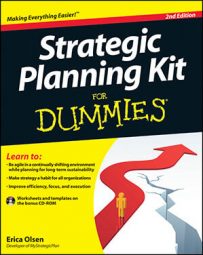By embedding your strategic plans into daily operations, completing items on your strategic plan becomes natural instead of something extra. Following are some quick ways to keep your strategic plan agile, preventing it from landing on the shelf and collecting dust.
Delete the fluff from your strategic plan
The sure death of a strategic plan is entombing it in hundreds of pages of text. Less is more. Delete the nonessential text that just clutters up the page. Stick to the essentials of your plan. Remember the size of your plan is directly inverse to your ability to implement it.
You can find a good example of a strategic plan that doesn’t have any fluff on the OnStrategy website.
Your strategic plan isn’t a business plan. Your strategic plan is a guide and a road map that tells how to get from where you are to where you want to be. Every part of your plan has a role in clearly defining that journey. Unlike a business plan, you’re not explaining your business to the reader. You, your staff, and your board members are the readers of the plan. Your plan isn’t a sales piece but rather an action piece. It’s a document that articulates what you are and aren’t going to do.
Use a KISS to implement your strategic plan
When all else fails — keep it simple, stupid. (no, it’s not cool to call anyone stupid, but that’s what the last s of KISS stands for.) For your strategic plan to be implemented, everyone in your organization has to understand it. Falling prey to big business lingo and confusing jargon diminishes the effectiveness of your plan. Developing a confusing strategic plan is really easy, so resist the urge.
Create a strategic plan poster (real and virtual)
By putting your strategic plan on one huge page, you keep your strategic plan from even touching the shelf (unless, of course, you have a really big shelf). Yes, you need backup documentation, which can be in that three-ring binder on a shelf, but put the key parts of your strategic plan on one page designed for the wall, your internal website, and social media websites. Enlarge the hard-copy page at your local print shop and hang it in your break room or common area. The poster helps keep everyone focused on your organization’s strategic direction.
Use a scorecard to track progress on your strategic plan
Keeping your plan alive requires constant communication, which can seem like too big a task and may just fall to the wayside. But if your staff doesn’t know where it stands, it’s impossible to keep implementing your plan. Some people like to play ignorant, and ignorance is bliss.
Use a scorecard to keep everyone in the loop. A scorecard provides a quick snapshot of who’s contributing and who isn’t. The scorecard allows you to track the monthly progress of each goal by listing the status of the goal. Ideally, you’ve developed measurable goals and have numbers associated with the status of each goal every month.
Think about your scorecard as your one-page progress report of every goal in your plan. Turn the scorecard into charts and graphs, and you have a quick visual that communicates your progress and is fun to look at. The scorecard may also help employees hold each other accountable for their part in meeting the strategic plan.

